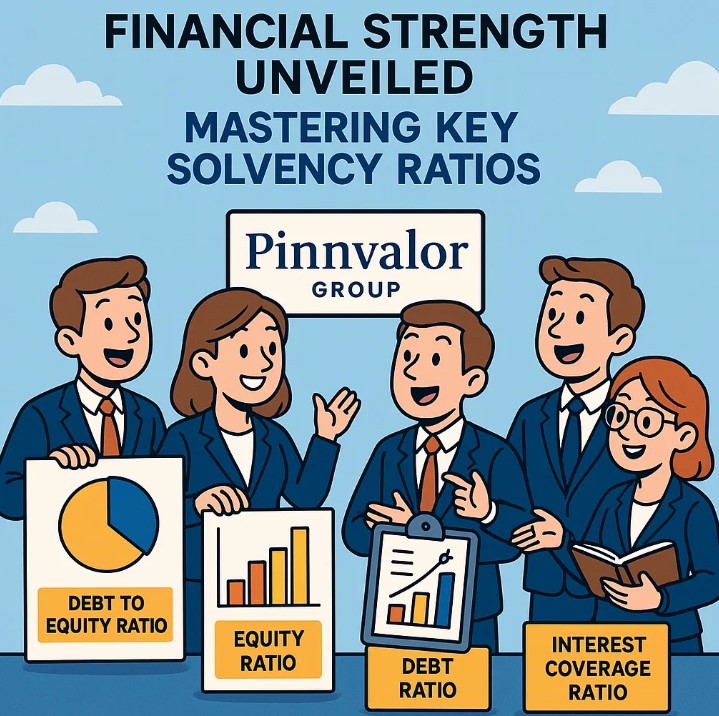
Financial Strength Unveiled: Mastering Key Solvency Ratios
In today’s volatile financial landscape, the ability to assess a company’s long-term viability is more critical than ever. Investors, lenders, and stakeholders alike seek insights that go beyond revenue and profit figures. This is where solvency ratios come into play—offering a window into a company’s ability to meet its long-term financial obligations.
Can your company weather financial storms, or are hidden debts dragging it down?
Profitability shines bright—but solvency is the foundation that holds it all together. Master the ratios that matter.
Among the most widely used solvency metrics are the Debt-to-Equity Ratio (D/E), Debt Service Coverage Ratio (DSCR), and Interest Coverage Ratio (ICR). This blog explores how each of these ratios works, what they indicate, and how they collectively shape a comprehensive picture of financial health.
🔍 What Are Solvency Ratios?
Solvency ratios are financial metrics used to evaluate a company’s ability to meet its long-term debt obligations. Unlike liquidity ratios, which focus on short-term financial stability, solvency ratios assess overall financial leverage and stability over time. They are crucial for stakeholders making strategic decisions—be it for investment, credit approval, or mergers and acquisitions.
⚖️ 1. Debt-to-Equity Ratio (D/E)
Formula:
Debt-to-Equity Ratio = Total Debt / Total Equity
Interpretation:
This ratio shows how much debt a company uses to finance its assets compared to the equity contributed by shareholders. It reflects the financial leverage of a business.
- A high D/E ratio may indicate higher financial risk, particularly in capital-intensive industries.
- A low D/E ratio suggests a conservative financing structure, which may appeal to risk-averse investors.
Industry Insight:
Acceptable D/E ratios vary across industries. For example, a utility company may naturally carry more debt than a tech startup due to stable cash flows and capital needs.
💼 2. Debt Service Coverage Ratio (DSCR)
Formula:
DSCR = Net Operating Income / Total Debt Service
Interpretation:
DSCR measures a company's ability to cover its debt payments (principal + interest) from its operating income. A DSCR of 1.0 means the company generates just enough income to meet debt obligations; anything above 1.0 indicates a surplus.
- A DSCR below 1 raises red flags for creditors and signals possible solvency issues.
- A DSCR of 1.5 or more is typically considered healthy, depending on the sector and economic climate.
Application:
Lenders often use DSCR to assess whether a borrower can take on additional debt. It's also a vital metric for project financing and leveraged buyouts.

💵 3. Interest Coverage Ratio (ICR)
Formula:
ICR = EBIT (Earnings Before Interest and Taxes) / Interest Expense
Interpretation:
The Interest Coverage Ratio reveals how easily a company can pay interest on its outstanding debt using its earnings. It’s a direct indicator of a firm’s ability to handle interest obligations without sacrificing operations.
- An ICR below 1.5 is generally considered risky.
- An ICR above 3 implies strong interest-paying capacity, often associated with financially sound companies.
📊 Why These Ratios Matter
These ratios provide crucial insights to:
- Investors: to gauge financial stability and potential risks
- Lenders: to assess repayment capability before issuing loans
- Management: to make strategic decisions around capital structure and financing
- Credit Rating Agencies: to evaluate creditworthiness
Collectively, they empower stakeholders to make informed decisions rooted in financial resilience rather than surface-level profitability.
🧭 Best Practices for Interpreting Solvency Ratios
- Compare across time: Analyze trends in ratios over several years for deeper insights.
- Benchmark against peers: A single ratio is more meaningful when contextualized within the industry average.
- Use in combination: Never rely on one ratio alone; D/E, DSCR, and ICR together offer a holistic view.
✅ Conclusion: Strength Lies in Solvency
Understanding and effectively analyzing solvency ratios is essential for evaluating a company’s financial strength. Whether you're an investor evaluating long-term prospects, a lender managing credit risk, or a CFO steering capital strategy, these ratios are powerful tools in your financial toolkit.
